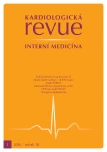New views on pathophysiology, diagnostics and treatment of heart failure with preserved ejection fraction
Authors:
J. Hradec
Authors‘ workplace:
III. interní klinika 1. LF UK a VFN v Praze
Published in:
Kardiol Rev Int Med 2016, 18(1): 8-12
Category:
Cardiology Review
Overview
Heart failure with preserved ejection fraction (HFpEF) is associated with significant morbidity and mortality and accounts for approximately one half of all patients with chronic heart failure. It is characterised by a complex pathophysiology, including multiple aetiologic mechanisms, and is accompanied by a broad spectrum of comorbidities in addition to a whole range of clinical manifestations. Proven therapies other than diuretics are lacking. The failure to develop successful therapies for the management of HFpEF may be explained by an overly broad definition of the disease and inadequate differentiation of its subtypes. Progress in the understanding of complicated pathophysiology is leading to the testing of new therapies directed at improving the symptoms as well as survival. Clinical trials are more targeted at specific subgroups or specific phases of this clinical syndrome. An example is the testing of heart rate slowing by ivabradine. The PARAGON-HF clinical trial is now testing the very promising dual humoral inhibition of RAAS and neprilysin by drug LCZ696. Different non-pharmacological therapies are also tested in smaller trials.
Keywords:
diastolic dysfunction – heart failure with preserved ejection fraction – targeted therapy – inhibition of the renin-angiotensin-aldosterone system
Sources
1. Tannenbaum S, Sayer GT. Advances in the pathophysiology and treatment of heart failure with preserved ejection fraction. Curr Opin Cardiol 2015; 30 : 250 – 258. doi: 10.1097/ HCO.0000000000000163.
2. Hradec J. Diagnóza psaná klínovým písmem – editorial. Vnitř Lék 2014; 60 : 553 – 554.
3. Jumean MF, Konstam MA. Heart failure with preserved ejection fraction. What is in name? Cardiol Rev 2015; 23 : 161 – 167. doi: 10.1097/ CRD.000000000 0000057.
4. Pellicori P, Cleland JG. Update on management of heart failure with preserved ejection fraction. Curr Opin Cardiol 2015; 30 : 173 – 178.
5. Paulus WJ, Tschöpe C. A novel paradigm for heart failure with preserved ejection fraction: comorbiditis drive myocardial dysfunction and remodeling through coronary microvascular inflammation. J Am Coll Cardiol 2013; 62 : 263 – 271. doi: 10.1016/ j.jacc.2013.02.092.
6. Mohammed SF, Mirzoyev SA, Edwards WD et al. Left ventricular amyloid deposition in patients with heart failure and preserved ejection fraction. JACC Heart Failure 2014; 2 : 113 – 122. doi: 10.1016/ j.jchf.2013.11.004.
7. Adamson PB, Abraham WT, Bourge RC et al. Wireless pulmonary artery pressure monitoring guides management to reduce decompensation in heart failure with preserved ejection fraction. Circ Heart Fail 2014; 7 : 935 – 944. doi: 10.1161/ CIRCHEARTFAILURE.113.001229.
8. Yusuf S, Pfeffer MA, Swedberg K et al. Effects of candesartan in patients with chronic heart failure and preseerved left ‑ ventricular ejection fraction: the CHARM ‑ Preserved Trial. Lancet 2003; 362 : 777 – 781.
9. Cleland JG, Tendera M, Adamus J et al. The perindopril in elderly people with chronic heart failure (PEP ‑ CHF) study. Eur Heart J 2006; 27 : 2338 – 2345.
10. Massie BM, Carson PE, McMurray JJ et al. Irbesartan in patients with heart failure and preserved ejection fraction. N Engl J Med 2008; 359 : 2456 – 2467. doi: 10.1056/ NEJMoa0805450.
11. EdelmannF, Wachter R, Kraigher ‑ Krainer E et al. Effect of spironolactone on diastolic function and exercise capacity in patients with heart failure with preserved ejection fraction. JAMA 2013; 309 : 781 – 791. doi: 10.1001/ jama.2013.905.
12. Pitt B, Pfeffer MA, Assmann SF et al. Spironolactone for heart failure with preserved ejection fraction. N Engl J Med 2014; 370 : 1383 – 1392. doi: 10.1056/ NEJMoa1313731.
13. Redfield MM, Chen HH, Borlaug BA et al. Effect of phosphodiesterase ‑ 5 inhibition on exercise capacity and clinical status in heart failure with preserved ejection fractuion: a randomized clinical trial. JAMA 2013; 309 : 1268 – 1277. doi: 10.1001/ jama.2013.2024.
14. Kosmala W, Holand DJ, Rojek A et al. Effect of If ‑ channel inhibition on hemodynamic status end exercise tolerance in heart failure with preserved ejection fraction: a randomized trial. J Am Coll Cardiol 2013; 62 : 1330 – 1338. doi: 10.1016/ j.jacc.2013.06.043.
15. McMurray JJ, Packer M, Desai AS et al. Angiotensin‑neprilysin versus enalapril in heart failure. N Engl J Med 2014; 371 : 993 – 1004. doi: 10.1056/ NEJMoa1409077.
16. Solomon SD, Zile M, Pieske B et al. The angiotensin receptor neprilysin inhibitor LCZ696 in heart failure with preserved ejection fraction: a phase 2 double blind randomized controlled trial. Lancet 2012; 380 : 1387 – 1395. doi: 10.1016/ S0140 - 6736(12)61227 - 6.
17. McMurray JV, Adamopoulos S, Anker SD et al. ESC Guidelines for the diagnosis and treatment of acute and chronic heart failure 2012. The Task Force for the Diagnosis and Treatment of Acute and Chronic Heart Failure 2012 of the European Society of Cardiology. Developed in collaboration with the Heart Failure Association (HFA) of the ESC. Eur Heart J 2012; 33 : 1787 – 1847. doi: 10.1093/ eurheartj/ ehs104.
18. Hradec J, Vítovec J, Špinar J. Souhrn Doporučených postupů ESC pro diagnostiku a léčbu akutního a chronického srdečního selhání – 2012. Připraven Českou kardiologickou společností. Cor Vasa 2013; 55 : 33 – 48.
19. Yancy CW, Jessup M, Bozkurt B et al. American Colege of Cardiology Foundation/American Heart Association guideline for the management of heart failure. J Am Coll Cardiol 2013; 62: e147 – e239. doi: 10.1016/ j.jacc.2013.05.019.
Labels
Paediatric cardiology Internal medicine Cardiac surgery CardiologyArticle was published in
Cardiology Review

2016 Issue 1
Most read in this issue
- Proton pump inhibitors – new molecules, new knowledge
- What to use in patients with ischaemic heart disease and atrial fibrillation – anticoagulation, antiaggregation or both?
- Cardiac cachexia
- Hyperuricaemia, cardiovascular diseases and heart failure
